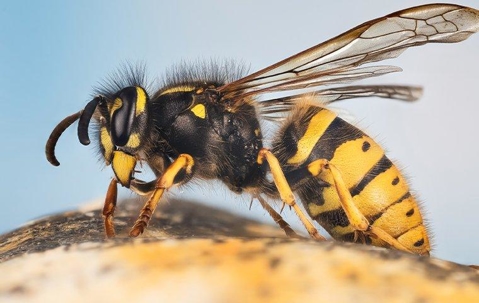Flying insects continually hover over people and startle them with their quick movements. It’s hard to have an outdoor event in peace because of them. That’s only the start of their trouble though. Should you be stung by one, the results can be dire. You may fall ill, develop a disease, or have contact with bacteria. Bees and wasps carry venom so they can debilitate prey. The substance can be rather powerful. Bugs buzzing around your New Jersey home or business is not a good look. Not only will you be at risk, but your visitors will too.
Insects with stinging capabilities are categorized as wasps. Yellow jackets are just one species that are dominant in the city. Their feeding and pollination habits help sustain the environment, but that is of no matter to humans who could be hurt. Learn more about their dangers, and how you can avoid them with assistance from Heritage Pest Control.
How Do Yellow Jackets Behave? What Are the Hazards?
True to their name, yellow jackets have yellow and black coloring. Given this, it’s easy for them to be mistaken for bees. However, their skin is less hairy and their waists are slimmer. In addition, some of the bugs in this class are black and white. Their bodies are about 0.39 to 0.62 of an inch long, but their wings extend further.
When yellow jackets get hungry, they’ll chew on fellow insects. They’ll also consume nectar, meat, and sugar. These elements are what bring them to homes and businesses. You can expect them to be near gardens, grills, garbage cans, and similar as a result. With time, they’ll get settled and build their nests around sidewalks, tree bases, and structural voids. Some will be dangling from patios, decks, and attics too. Seeing an aerial cocoon is a definite sign of infestation because yellow jackets typically form them at the ground level. Keep an eye on branches and shrubs.
Stings from yellow jackets are quite painful. There will be swelling and redness at the site, accompanied by itching and warmth. No matter if someone has a venom allergy or not, there might be a significant physical reaction. These pests are markedly aggressive; they attack in groups and can strike multiple times. You may experience these symptoms:
- Inflammation of the brain, nerves, or blood vessels
- Flushed skin
- Respiratory difficulties
- Cardiorespiratory arrest
- Fainting
- Diarrhea
- Fever
- Nausea
- Headache
- Convulsions
- Kidney complications
What Can Be Done to Prevent Yellow Jackets?
Since there is no controlling the natural world that yellow jackets love, you have to focus on your land and its maintenance. Intricate exterior care can help lessen attraction points and the available spaces for nesting:
- Mow the lawn and trim the greenery regularly.
- Distance plants and flowers from the property by two feet or more.
- Discard organic debris and yard trash, such as rotting leaves.
- Wash out your gutters and vents on a routine basis.
- Put garbage in a secure canister.
- Don’t leave food on decks and porches, and make sure these areas stay clean.
- Close up holes in foundations, windows, and doors.
- Contact Heritage Pest Control if you have critters yellow jackets eat
How Will Heritage Pest Control Handle Yellow Jackets?
You shouldn’t get close to yellow jackets or their nests. Don’t take a chance of aggravating them or being stung. Retail products for these bugs aren’t reliable, and won’t eliminate an infestation. Even worse, they could be too noxious for vegetation, pets, or humans. We at Heritage Pest Control have safe solutions that are either environmentally friendly or synthetic. Our technicians are highly trained and experienced.

